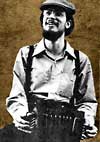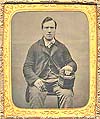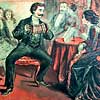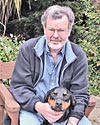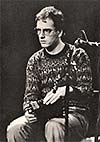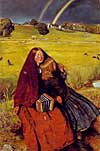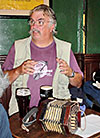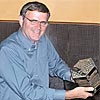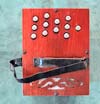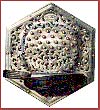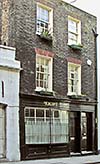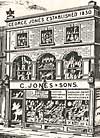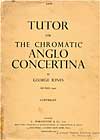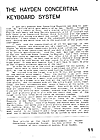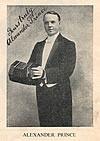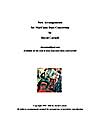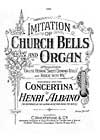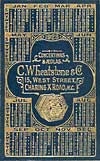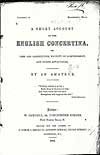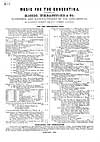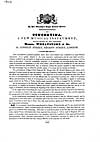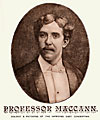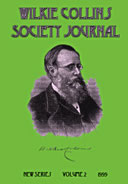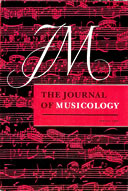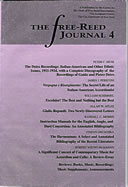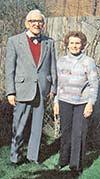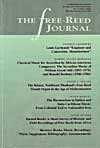Index of Sections
Directory
This is an index of the major sections in the Concertina Library,
with some of the documents most often sought.
It does not contain a link to every document on the site (for that, see the
archive of items added each year,
or the site map).
Click on a section listed here to see an index of all the documents in that section.
-
 Search the Concertina Library
Search the Concertina Library
-
by Robert Gaskins
-
-
The Concertina Library (this site) is an online reference library for all concertinas,
including the English concertina, Anglo concertina, and several kinds of Duet concertina systems,
with particular strength in the Maccann Duet concertina.
It contains instruction books, concertina sheet music, history documents,
patents, technical papers, and new research articles by leading
scholars, video and audio of concertina players plus links to other concertina websites.
Read, download, print—all free.
-
Posted 15 February 2001
-
» go to website
-
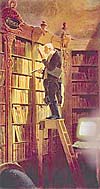 About the Concertina Library
About the Concertina Library
-
by Robert Gaskins
-
Information about how to use the Concertina Library.
Goals
Organization
How to make the text bigger or smaller
How to improve the screen appearance
How to print documents
About PDF format documents
Resources used by this website
How to cite the Concertina Library
How to link to the Concertina Library site
How to link to Concertina Library documents from the concertina.net forums
Background (the old Maccann Duet Concertina site)
How to subscribe to updates
Future Developments
Send Us a File
-
Posted 01 January 2005
-
» read full article
-
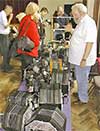 Worldwide Real-Time eBay Listings for “Concertina”
Worldwide Real-Time eBay Listings for “Concertina”
-
by Robert Gaskins
-
Latest listings from eBay sites around the world, retrieved anew
each time this webpage is loaded, linked to the eBay items.
Can be configured to perform other searches, on any one or more of the eBay national sites.
Includes listings from eBay United States, eBay United Kingdom, eBay Ireland, eBay Australia,
eBay Germany, eBay Austria, eBay Switzerland, eBay Spain, eBay France,
eBay Netherlands, eBay Italy, eBay Belgium, eBay Canada, eBay Taiwan, eBay China, and eBay India.
Auctions at eBay are generally poor
places to find playable instruments, but have unearthed much general
knowledge about ordinary concertinas and occasional museum pieces.
-
Posted 01 January 2005
-
» read full article
-
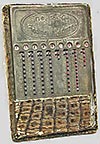 Calculate Modern Values of Historic Concertina Prices
Calculate Modern Values of Historic Concertina Prices
-
by Randall C. Merris and Robert Gaskins
-
“How much would that be in new money?”
An interactive calculator to convert sterling values from any
year 1830–1999 to the equivalent value in the year 2000.
The calculation preserves the relation between the chosen value and
“average earnings” for the two dates; this method makes it
appropriate for converting wages and capital sums, and also for
expensive discretionary products such as concertinas. The calculator deals
with both “old money” (prior to 1971) and the later decimalized
currency. It is especially useful for understanding historical documents such
as old advertisements and pricelists, and the sales prices and wages
recorded in the
Wheatstone Concertina Ledgers
from the Horniman Museum.
-
Posted 01 January 2005
-
» read full article
-
 Guide to Concertinas on the Web
Guide to Concertinas on the Web
-
Directory
-
Directory of some leading websites that contain information about concertinas.
Each site has a brief description and screen shot, and custom search boxes
allow you to search each site individually or to search all of the sites at one time.
-
Posted 01 January 2005
-
» go to directory
-
 Concertina Systems
Concertina Systems
-
Directory
-
Concertina Library directory of all information on this website about
different types of Concertina Systems.
-
Posted 01 January 2005
-
» go to directory
-
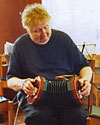 Hayden System Duet Concertinas
Hayden System Duet Concertinas
-
Directory
-
Concertina Library directory of all information on this website about Hayden System Duet Concertinas,
including most of Brian Hayden's published articles.
-
Posted 01 January 2005
-
» go to directory
-
 Historic Concertina Makers
Historic Concertina Makers
-
Directory
-
Concertina Library directory of all information on this website about historic
concertina makers, so far including C. Wheatstone & Co., Lachenal & Co.,
C. Jeffries Maker, George Jones & Sons, H. Crabb and Son.
-
Posted 01 January 2005
-
» go to directory
-
 C. Jeffries, Maker
C. Jeffries, Maker
-
Directory
-
Concertina Library directory of all information on this website about C. Jeffries Maker and Jeffries Brothers.
-
Posted 01 January 2005
-
» go to directory
-
 Fingering Charts for Concertinas
Fingering Charts for Concertinas
-
by Wes Williams
-
Keyboard diagrams for the most important concertina
fingering systems: English, Anglo, and Maccann Duet, plus Early Wheatstone Double Duet,
Early Wheatstone "Duett" Duet, Crane (or Triumph) Duet, Jeffries System Duet,
Late Wheatstone Chidley Duet, and Hayden (or Wicki) Duet.
-
Posted 07 March 2005
-
» read full article
Maccann Duet Concertina
-
 How to Play Chords on Any Maccann Duet Concertina
How to Play Chords on Any Maccann Duet Concertina
-
by Robert Gaskins
-
Explains how to play chords to accompany songs on Maccann Duet
concertinas of any size and from any period. Intended for beginners,
assumes no knowledge of musical notation or theory.
Includes a chord chart suitable for the lid of a concertina case. 51 pages.
-
Posted 15 February 2001
-
» read full article in pdf
-
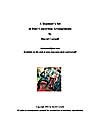 A Beginner's Set of Duet Concertina Arrangements
A Beginner's Set of Duet Concertina Arrangements
- by David Cornell
-
Six arrangements all in the key of C and progressing from easy to more
difficult, with detailed comments on fingering and technique and a
diagram of left hand bass pattersns. Includes: On Top of Old Smokey (two versions), Oh Susanna,
The Battle Hymn of the Republic, Sweet Sixteen, and Scotland the Brave.
18 pages.
- Posted 27 December 2001
-
» read full arrangements in pdf
-
 New Method of Instructions for the New Chromatic Duet English Concertina ... &c.
New Method of Instructions for the New Chromatic Duet English Concertina ... &c.
-
by John Hill Maccann
-
Maccann’s own tutor, first
published 1885 by Lachenal. Cover reads in part: "New Method
of Instructions for the New Chromatic Duet English Concertina,
with separate diagrams of keyboards and full instructions of
proper fingering, so arranged that without a knowledge of music
the instrument can be easily mastered ... Suitable for the 39,
47, or 56 Keyed Instrument. By J. H. Maccann, (Professor of the
Duet English Concertina)." First edition, London: Lachenal & Co., 1885. 43 pages.
Trim size 10 inches by 13 inches.
Updated 01 July 2003: Fourth edition (date unknown),
the cover of which reads in part "Suitable for the 39,
46 or 55 Keyed Instrument." 4th Edition. 43 pages.
This copy was provided by Bradley Strauchen, Deputy Keeper of Musical Instruments
at the Horniman Museum.
-
Posted 15 February 2003; last updated 01 July 2003
-
» (1st ed.) read full document in pdf
-
» (4th ed.) read full document in pdf
-
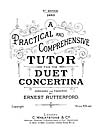 A Practical and Comprehensive Tutor for the Duet Concertina
A Practical and Comprehensive Tutor for the Duet Concertina
-
by Ernest Rutterford
-
The tutor for the Maccann Duet concertina which was published and sold
by Wheatstone over a very long period. It does not contain the name "Maccann,"
but refers only to the Wheatstone Duet.
(Wheatstone's Instructions for the Duet Concertina.) 4th ed.
London: undated (1930's?). From an original owned by Chris Algar. 56 pages.
-
Posted 15 November 2001
-
» read full article in pdf
-
 Maccann Duet Chords Tutor Manuscript
Maccann Duet Chords Tutor Manuscript
-
from Robert Gaskins
-
A polished 76-page manuscript “chords tutor” found in the
case of a matching 57-key Maccann Duet made by C. Jeffries Maker, 23 Praed St.
The instrument and the tutor are dated c. 1915. This may have been a “semi-bespoke”
tutor included with the instrument when it was originally sold.
Unlike the much later Jeffries System manuscript tutor (c. 1960) written with a biro
(ballpoint pen) in very rough style, this much-longer document was written with a split pen and
is very carefully finished.
-
Posted 15 February 2003
-
» read full document in pdf
-
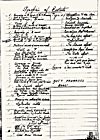 Stanley Manuscript Maccann Duet Tutor
Stanley Manuscript Maccann Duet Tutor
-
by Henry Stanley
-
One of a number of similar manuscript tutors for the Maccann Duet
Concertina written by Henry Stanley for his private pupils. Exercises,
scales, chords, tunes of graduated difficulty, tips on technique.
Hand written on music paper, 41 pages. This copy
belongs to Richard Evans.
-
Posted 15 May 2003
-
» read full document in pdf
-
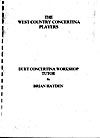 All-Systems Duet Workshop Tutor
All-Systems Duet Workshop Tutor
-
by Brian Hayden
-
Tutor for a workshop on how to play duet concertinas of all systems. Begins
with notation, fingering, and chords for Maccann Duets, Jeffries Duets, Crane (Triumph)
Duets, and Hayden Duets. Tunes of progressive difficulty, with increasing
number of notes and then in keys with increasing numbers of accidentals, all
written in notation based on the treble clef. Notes
on chord patterns and on strategies for melody and accompaniment applicable to
all systems of duet concertina.
Presented to The West Country Concertina Players, 1994. 20 pages.
-
Posted 15 August 2003
-
» read full document in pdf
-
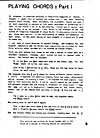 Playing Chords [for English, Anglo, and Maccann Duet]
Playing Chords [for English, Anglo, and Maccann Duet]
-
by Brian Hayden
-
"I would like to explain the system that I use when teaching
players about chords, their structure, and placement. Chords are
what I am most requested to explain at folk music workshops or
gatherings as I tend to use chords a lot in my own playing." (From
the introduction.)
Includes a novel notation for chords which is used elsewhere on this website.
As published in Concertina Magazine
(Australia) in three parts, 12-14 (1985), 12:5-7,
13:12-14, and 14:8-10; with corrections in 15-16 (1986), 15:14
and 16:1,6,9.
-
Posted 01 March 2004
-
» read full article in pdf
-
 Garland Films Presents: “Reuben Shaw—Duet Concertina Player”
Garland Films Presents: “Reuben Shaw—Duet Concertina Player”
- by Barry Callaghan
-
On 7 February 1987, Barry Callaghan of Garland Films with fieldworker Graham Coyne
filmed a lengthy interview and demonstration, in which Reuben Shaw talks about his life and music.
He discusses early performers, his difficulties in finding music to study, and plays
the Maccann Duet concertina
from some of his collection of Henry Stanley manuscript arrangements.
This film has been available from Garland Films on PAL VHS tapes for some time, but now the entire film
is available on this website and is available on DVD from Garland Films.
STATUS: Article is online now with still pictures, but
video clips are not yet available for streaming (in production now).
- Posted Coming soon
- » read full article
-
 Which Duet Concertina—Hayden or Maccann?
Which Duet Concertina—Hayden or Maccann?
-
by Robert Gaskins
-
A comparative review of two concertinas:
a Stagi Hayden Duet concertina (c. 2003),
and a Lachenal Maccann Duet concertina (c. 1900).
Each instrument has 46 keys, and each cost
£500 ($800) ready to play.
On almost every measure, the antique Lachenal Maccann Duet
turned out to be preferable to the modern Stagi Hayden Duet—by
a considerable margin. The advantages frequently mentioned as
belonging to the Hayden system (uniformity of fingering in all
key signatures, automatic transposition) turned out to be significantly
compromised by the restricted size of the Stagi. If you want to
play a duet concertina, at present you will probably do best to
buy a Maccann Duet.
-
Posted 01 March 2004
-
» read full article
English Concertina
-
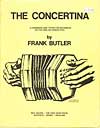 The Concertina: A Handbook and Tutor for Beginners on the English Concertina
The Concertina: A Handbook and Tutor for Beginners on the English Concertina
-
by Frank E. Butler
- The standard tutor for the English concertina during
the concertina revival in the 1970s. Based on classes offered at the Battersea
Institute under the auspices of the Inner London Education Authority. Introduction
to music, exercises, and elementary tunes.
Originally published by Neil Wayne at the Free Reed Press,
Duffield, Derby, England, in 1974. 64pp plus covers. The scan was made by
Wes Williams.
-
Posted 15 January 2005
-
» read full document in pdf
-
 Signor Alsepti and “Regondi’s Golden Exercise”
Signor Alsepti and “Regondi’s Golden Exercise”
-
by Allan Atlas
-
Discussion and explanation with new fingering of a celebrated excercise from James Alsepti's English tutor,
published by Lachenal c. 1895, with the explanation “The following exercise, which has never before been
published, was taught to Signor Alsepti by Regondi. It is
very difficult for all instruments, especially the Concertina, and to thoroughly master it with the correct
fingering &c. will enable the Pupil to play passages in all keys.”.
As published in
Concertina World 426 supplement (2003) pp. 1-8.
-
Posted 22 December 2003
-
» read full article
-
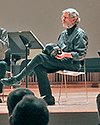 The Victorian Concertina: Some Issues Relating to Performance
The Victorian Concertina: Some Issues Relating to Performance
- by Allan W. Atlas
- Present-day players of the ‘English’ concertina must make a number
of important decisions when delving into and performing the large repertory of
art music that was written for the instrument in Victorian England. These
decisions become especially critical for those who would perform the music in a
manner that may at least approximate the way it may have sounded in the nineteenth
century.
Originally published in Nineteenth-Century Music Review, 3/2 (2006),
30 pages including photographs and musical examples.
Briefly, there are three basic decisions to be made. The first
two concern the choice of instrument: (1) modern instrument or period (Victorian)
instrument; and (2) if the latter, what kind of instrument in terms of reeds (type
of metal), tuning, structure of the bellows and number of buttons. The third
decision, on the other hand, has to do with a fundamental question of playing
technique: should we use three or four fingers of each hand?
- Posted 15 November 2007
- » read full article
Anglo Concertina
-
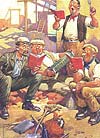 “Faking It”
“Faking It”
-
by Roger Digby
with a section on the Duet Concertina by Kurt Braun
-
Subtitled "A guide to selecting appropriate chords
on the Anglo and Duet Concertinas".
Explains how to play the concertina from a “fake book” or “busker’s book”,
which gives a melody line and an indication of the chords for accompaniment. 16pp.
Originally published for the ICA, 2004.
-
Posted 15 August 2005
-
» read full document
-
 “Faking It”: a dozen examples
“Faking It”: a dozen examples
-
by Roger Digby
-
Musical examples to accompany the web publication of “Faking It”.
Twelve tunes that are common in sessions and include most of the dance rhythms,
six tunes in C and six in G as the most common Anglo keys. Each tune is represented
by the music (printed without chords), and also by a sound file of Roger Digby
playing the Anglo concertina as you might hear at a casual session.
Originally presented at a workshop for the
East Anglian
Traditional Music Trust, 2004.
Tunes include: Blaydon Races, Dannish Waltz, Dorset Four Hand Reel,
Family Jig, Galopede, Greensleeves, Harry Cox’s Schottisch, Keel Row,
Shepton Mallet Hornpipe, The Man in the Moon, Three Around Three, and Winster Galop.
-
Posted 15 August 2005
-
» read full article
-
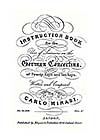 Earliest Known English-Language German Concertina Tutor: Minasi’s “Instruction Book” 1846
Earliest Known English-Language German Concertina Tutor: Minasi’s “Instruction Book” 1846
- by Randall C. Merris and Dan Worrall
-
Carlo Minasi published the earliest known English-language tutor for the German ("Anglo-German") concertina
by 1846 in London.
This publication goes well beyond the basics; in it are instructions not only
for the simple “along the row” melody line style, but also extensive discussions of octave
playing, cross row fingering, and chord accompaniment.
Numerous fully arranged musical selections are included,
almost all in the “English” or “harmonic” style, where chords are played on the
left and melody on the right, more or less as a duet concertina is played.
- Posted 15 August 2005
- » read full article
Other Duet Systems
-
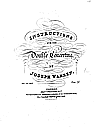 Instructions for the Double Concertina
Instructions for the Double Concertina
-
by Joseph Warren (C. Wheatstone & Co.)
-
A complete tutor for the Double duet, with an introduction devoted to the theory
of the keyboard arrangement and the leveraging of patterns among key signatures.
Published by Wheatstone & Co., deposited at the British Museum
28 July 1855. 27 pages. Printed in large format, trim size 9.5 inches by 14 inches.
-
Posted 15 February 2003
-
» read full document in pdf
-
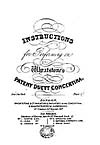 Instructions for Performing on Wheatstone's Patent Duett Concertina
Instructions for Performing on Wheatstone's Patent Duett Concertina
-
by Anonymous (C. Wheatstone & Co.)
-
From page 2: "Many persons having formed opinions very prejudicial
to the Concertina, in consequence of mistaking for the original, an
imitation called the German Concertina, the public is informed
that, the so called instrument is totally different (with the exception
of the exterior) ... ."
Published by Wheatstone & Co., deposited at the
British Museum 28 July 1855. 21 pages. Trim size 6.5 inches by 10 inches.
-
Posted 15 February 2003
-
» read full document in pdf
-
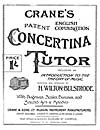 Crane's Patent English Combination Concertina Tutor
Crane's Patent English Combination Concertina Tutor
-
by H. Wilston-Bulstrode
-
The earliest tutor for Crane-system duets, published for
Crane's of Liverpool. Contains key diagrams for
instruments from 35 keys to 55 keys, theory, exercises, and
a number of tunes.
Published by Lachenal & Co., c. 1896. 54 pages.
From the introduction: “Crane's Patent English Combination
Concertina has already won for itself a name among the best-known
masters of the instrument. Its capacity of execution, sweetness of
tone and adaptability for Harmonic combinations, taken with the
striking ease with which it may be learnt, even by the least
gifted musicians, must in due time cause it to be generally
regarded as the leading Concertina in the market, a position
which Messrs Crane & Sons Ltd. unhesitatingly claim for it.”
-
Posted 15 February 2003
-
» read full document in pdf
-
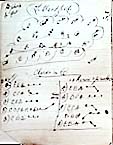 Jeffries Manuscript “Tutor” for Jeffries System Duet
Jeffries Manuscript “Tutor” for Jeffries System Duet
-
by Anonymous (Jeffries Bros.?)
-
Undated manuscript (possibly as late as 1959) showing fingering and chords
for a Jeffries System Duet, apparently made by the Jeffries company. The
document is fashioned from a notebook with pages cut so that the keyboard diagrams can
remain static at the top while partial pages of chords and instructions for various
keys can be turned below. Unlike the early Jeffries Maccann manuscript tutor
(c. 1910) written with a split pen and very finished, this document is written with a biro
(ballpoint pen) indicating a much later date, and is very rough.
Manuscript now in the collection of the Horniman Museum, London (Item CM C1080).
The notebook is at present contained in an envelope along with a letter from
Thomas Jeffries dated 1959 which may or may not be related.
-
Posted 15 February 2003
-
» read full document in pdf
-
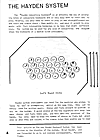 The Hayden System
The Hayden System
-
by Brian Hayden
-
Hayden's early (1983) account of the advantages of the Hayden system,
stressing the ease of forming chords in any key and of transposing.
As published in Concertina Magazine
(Australia) 8 (Autumn, 1984): 4-8.
-
Posted 15 February 2003
-
» read full article in pdf
-
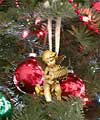 Christmas Music for Concertina
Christmas Music for Concertina
- by David Cornell
-
Christmas music arranged for Maccann Duet concertina. Includes
Coventry Carol (with comments), Have Yourself a Merry Little Christmas,
Joy to the World, and We Wish You a Merry Christmas.
- Posted 15 December 2004
-
» go to directory
-
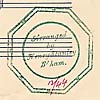 Arrangements of Music for Maccann Duet Concertina
Arrangements of Music for Maccann Duet Concertina
-
by Henry Stanley
-
Arrangements of music by Henry Stanley of Birmingham, a leading teacher and performer on
the Maccann Duet concertina from the period between world wars, and an early member of
the International Concertina Association. Stanley used his beautiful musical calligraphy
to write personal arrangements and tutors for his many pupils.
Most items from the Cecil C. White Archive of Henry Stanley Arrangements for Maccann Duet Concertina,
augmented by contributions from Richard Evans and others.
-
Posted 22 January 2005
-
» read full article
-
 ICA Library
ICA Library
-
by Dave Bissett, Librarian
-
Library of the International Concertina Association,
listing of music holdings which include about 150
arrangements for the Maccann Duet concertina and
many arrangements for English concertinas. (Music
is not yet available on the net, and can only be copied
for members.)
-
Posted 15 December 2001
-
» go to website
-
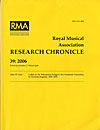 Ladies in the Wheatstone Ledgers: the Gendered Concertina in Victorian England, 1835–1870
Ladies in the Wheatstone Ledgers: the Gendered Concertina in Victorian England, 1835–1870
- by Allan W. Atlas
- This study looks at the 978 women for whom there are 1,769 transactions—about 12% of the
total—recorded in nine extant Wheatstone & Co. sales ledgers that list the firm’s day-to-day sales
from April 1835 to May 1870. It is in two parts: (1) an Introduction, which analyses the data presented
in the Inventory from a demographic-sociological point of view and places Wheatstone’s commerce
with women into the context of its business activity as a whole; and (2) the Inventory (with
three appendices), which lists every transaction for each of the 978 women, identifies as many of them
as possible, and offers a miscellany of comments about both the women and the transactions.
Royal Musical Association Research Chronicle v. 39 (2006). 239 pages.
Briefly,
the roster of Wheatstone’s female customers reads like a list of Victorian England’s rich-and-famous:
the Duchess of Wellington and 146 other members of the titled aristocracy (more than twice as many
as their male counterparts), the fabulously wealthy philanthropist Angela Burdett Coutts, members
of the landed gentry, and such mainstays of London’s musical life as the guitarist Madame R. Sidney
Pratten, the organist Elizabeth Mounsey, and the contralto Helen Charlotte Dolby, as well as a large
number of Professors of Concertina.
- Posted 21 March 2007
- » read full article
-
 The Concertina History Resource
The Concertina History Resource
-
by Wes Williams
-
This site (still early in its development) contains historical
information about concertinas and concertina makers. A timeline
helps to organize information about the changes of name and address
among the major makers as bits of data are discovered. One
use for this information is to help in answering the question “when
was my concertina made?” which is very difficult to answer
for most makers.
-
-
Posted 15 February 2003
-
» go to website
-
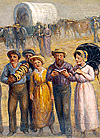 A Brief History of the Anglo Concertina in the United States
A Brief History of the Anglo Concertina in the United States
-
by Dan Worrall
-
In the United States the Anglo-German concertina was very popular during the middle and late
nineteenth century, but by the early twentieth century it had all but vanished from American popular
culture, becoming only a Hollywood symbol of “the old days”.
After the revival of interest in traditional music and in concertinas from the 1960s the Anglo has
once again had some popularity in the United States, but without connection to any tradition of its
earlier widespread use in America. This paper attempts to reconstruct a basic history
of the Anglo concertina in the U.S. by using nineteenth-century tutors, newspaper mentions,
anecdotes from family histories, and archival photographs.
Topics discussed include the early use of German concertinas in the Eastern U.S.,
the use of Anglo concertinas by Mormon and other western pioneers, use during the War Between the States,
use by African-Americans, use in nautical contexts, use by immigrant and other ethnic groups, and
use by the American branch of the Salvation Army. Some previously unpublished photographs are included.
-
Posted 15 April 2007
- » read full article
-
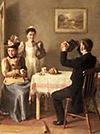 Notes on the Beginnings of Concertina Playing in Ireland, 1834–1930
Notes on the Beginnings of Concertina Playing in Ireland, 1834–1930
-
by Dan Worrall
-
Although the Irish are known for their long folk memory, the story of how of concertina
playing began there has been largely lost; it is often tagged to a threadbare tale of
mariners bringing them up the Shannon estuary to Clare. This paper reconstructs its history
by using period accounts from newspapers, books and family histories to document the social
gatherings where it was played, and the vendors who sold it. The Anglo-German concertina was
enormously popular all across Ireland during its heyday, amongst people of nearly all social and
economic groups.
The concertina is a much-favored instrument in County Clare, Ireland, and
a few players there bridge the gap in time between the instrument’s heyday in the
late nineteenth/early twentieth century and the current revival, which began in the 1970s.
Its later concentration in Clare was not a result of how it arrived, but
of local cultural and economic factors that aided its barest survival there while it was
completely dropped—and all but forgotten—elsewhere in the country.
-
Posted 15 November 2007
- » read full article
-
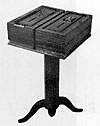 The Wheatstone English Concertina
The Wheatstone English Concertina
- by Neil Wayne
-
Survey article covering the Wheatstone English Concertina, the only
published source for much of Neil Wayne's path-breaking research.
As published in The Galpin Society Journal 44 (1991), 117-149. (The
online version does not yet perfectly match the printed version.)
- Posted 01 January 2005
-
» go to website
-
 The Wheatstone Factory in Islington, 1961
The Wheatstone Factory in Islington, 1961
- by British Pathe Newsreels
-
Concertinas are made and played at a
factory in Islington, 03 April 1961.
From newsreel "Colour Pictorial 327", 1961, Pathe Film ID 137.02.
Available for free preview at reduced quality at the British Pathe website.
Original title: "Concertina Factory
(aka Concert in a Factory)".
- Posted 01 January 2005
-
» go to website
-
 The Concertina Man
The Concertina Man
-
Presented by Peter Day,
Produced by Neil Koenig
-
BBC programme on the history and music of the concertina,
focusing on its inventor Sir Charles Wheatstone as a somewhat belated
recognition of his bicentenary in 2002. In addition to the presenter, Peter Day,
the program features (in order of appearance)
Bob Gaskins, Brian Bowers, Margaret Birley, Stephen Chambers,
Frank James, Douglas Rogers, Sean Minnie, and Steve Dickinson. The program
was produced by Neil Koenig.
BBC World Service programme broadcast 07 September 2004.
-
Posted 22 November 2004
-
» read full article
-
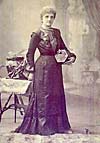 Marie Lachenal: Concertinist
Marie Lachenal: Concertinist
- by Faye Debenham and Randall C. Merris
-
New photographs, genealogical data, and information about
Marie Lachenal, eldest of Louis Lachenal’s daughters,
and about her family life as the wife of the photographer Edwin Debenham.
First published in
PICA [Papers of the International Concertina Association], Vol. 2 (2005), pp. 1–17.
The web version adds large colour photographs and additional information which
has been discovered since the text went to print.
- Posted 15 November 2005
- » read full article
-
 The Lachenal Sisters Visit Edinburgh, 1865–1866
The Lachenal Sisters Visit Edinburgh, 1865–1866
-
by Robert Gaskins
-
At Christmas of 1865–1866, three young daughters of the late Louis Lachenal gave a
series of concerts in Edinburgh introducing “concerted music” played
on treble, tenor, and bass concertinas. We think this was also exactly the period when
Lachenal & Co. had lost their contract to manufacture concertinas for Wheatstone,
making it important to publicize Lachenal’s own brand.
Based on clippings from The Scotsman newspaper, Edinburgh, notices of
concerts and reviews, October 1865 through January 1866.
-
Posted 01 February 2005
-
» read full article
-
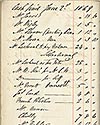 Wheatstone Concertina Ledgers
Wheatstone Concertina Ledgers
-
Directory
-
Historical business records of C. Wheatstone & Co. from
the Horniman Museum in London. Earlier ledgers from the Wayne Archives
contain company sales records from the late 1830s to the 1860s
along with production records from the 1860s to the 1890s and some
early records of wages and other payments. Later ledgers from the Dickinson Archives
contain production records from 1910 to 1974. All surviving ledgers
have been digitized (some 2,300 pages in total) and made available free on the web for
private research.
The same material is also available to buy on an inexpensive CD.
Includes an introduction to the project by Margaret Birley, Keeper of Musical Instruments at
the Horniman Museum, and an article by Robert Gaskins describing in detail how the ledgers
were digitized.
-
Posted 15 June 2003; Updated 15 June 2005
-
» go to directory
-
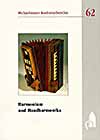 An Annotated Catalogue of Historic European Free-Reed Instruments from my Private Collection
An Annotated Catalogue of Historic European Free-Reed Instruments from my Private Collection
-
by Stephen Chambers
-
A very important paper describing nineteen instruments which illustrate key points in the development of
European free-reed instruments, with large color photographs.
This paper was presented at the 20th Musikinstrumentenbau-Symposium at Stiftung Kloster Michaelstein, held
19–21 November 1999, to coincide with an exhibition of the instruments.
As Published in Harmonium und Handharmonika (Michaelsteiner Konferenzberichte 62), edited by Monika Lustig,
Michaelstein, 2002, pp. 181-194.
-
Posted 15 January 2004
-
» read full article
-
 Concertina Pricelists
Concertina Pricelists
- collected by Chris Algar
-
A unique collection of nearly 40 pricelists for vintage concertinas,
mostly found in old concertina cases. From internal evidence it is
possible to date the Wheatstone pricelists with more or less accuracy, but the Lachenal pricelists
and others from dealers still have some uncertainty in dates.
- Posted 07 March 2005
- » go to directory
-
 The Concertinist's Guide
The Concertinist's Guide
-
by John Hill Maccann
-
The Most Simple Modern Methods; How to Play
Correctly, With or Without a Tutor
8vo. London: Howard & Co., 1888.
Images from a microfilm of a copy at the Bodleian Library, replacing
a British Library copy destroyed in World War II. (Former British Library
shelfmark D-7808.c.14.(14.), replaced by British Library microfilm
Mic.A. 10532(4), Bodleian Shelfmark 17426 e 3(2).) Also a full
transcription which is searchable in the Adobe PDF reader. 50 pages.
-
Posted 15 November 2001
-
» read full document in pdf
-
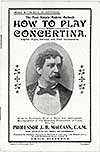 How to Play the Concertina
How to Play the Concertina
- by John Hill Maccann
-
A newly-discovered booklet, reliably dated to 1902.
The text of the document consists of two parts: (1) a
part of the "how to play" text from Maccann's earlier
publication The Concertinist's Guide (1888); and (2) an
interview with Professor Maccann reprinted from The Era
theatrical newspaper of London, issue of 25 January 1902.
In addition to the text,
the booklet contains some new photographs of Maccann,
including the first known photographs of him playing the concertina.
There is a sample program of a recital by Maccann, a list of phonograph
records for sale recorded by Maccann, and a catalogue of
some of Maccann's published music compositions.
This copy was discovered in the National Archives of
Australia, where it had been deposited for copyright registration.
- Posted 27 September 2004
-
» read article and full document
-
» read full document in pdf (medium quality)
-
» read full document in pdf (higher quality)
-
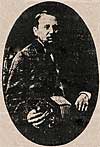 Recollections of the English Concertina, from 1844,
by George Jones, born February 29th 1832
Recollections of the English Concertina, from 1844,
by George Jones, born February 29th 1832
-
by George Jones
-
A full transcription of a manuscript now in the British Library, catalogued there as:
Additional Manuscript 71124 Q,
Recollections of the manufacture of the English concertina from 1844, by George Jones; [1912].
Presented by F. E. Butler, Esq., grandson of George Jones, 29 Aug. 1988, and incorporated in 1993.
ff. 331 x 207mm.
As published in Concertina Magazine, 13 (Winter 1985): 4–5, and
14 (Spring 1985): 4–7. Previously published (with heavy editorial additions) in
FreeReed: The Concertina Magazine, No. 16 (November 1973): 14–20.
A link is provided to PDF scanned versions of both publications.
-
Posted 15 January 2004
-
» read full article
-
» read 1985 publication in PDF
-
» read 1973 publication in PDF
-
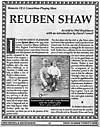 Memoirs of a Concertina-Playing Man: Reuben Shaw
Memoirs of a Concertina-Playing Man: Reuben Shaw
-
as told to Phil Hopkinson, with an introduction by David Cornell
-
Memoirs of a player, a teacher, a link with the great British concertina tradition, and
a fine story teller, who has played the Maccann Duet concertina for over fifty years.
Reprinted from Concertina & Squeezebox,
issue 29 (1993), pp. 12-17. Posted to honor Reuben Shaw’s 90th birthday, and to commemorate his
appearance at the English Country Music Weekend at High Bradfield, Nr Sheffield, UK, 20-22 June 2003.
-
Posted 15 June 2003
-
» read full article in pdf
-
 A Timeline of Snippets of Concertina History
A Timeline of Snippets of Concertina History
-
by Wes Williams
-
Facts about concertina history and brief self-explanatory clippings arranged in
a timeline. This arrangement frequently gives insight into dating instruments
or archival materials through their internal evidence.
-
Posted 15 February 2003
-
» go to website
-
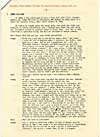 The Tommy Williams Story
The Tommy Williams Story
-
by Neil Wayne
-
Interview with Tommy Williams, Maccann Duet concertinist and former
Lachenal employee.
Published in three parts in Free Reed: The Concertina Newsletter,
3 (January 1972): 5–6;
5 (May 1972): 6–7;
and 7 (August 1972): 10–12.
-
Posted 15 November 2001; last updated 15 January 2004
-
» read full document in pdf
-
 Baffles for Maccann Duet Concertinas
Baffles for Maccann Duet Concertinas
- by Robert Gaskins
-
Explains how baffles fitted internally can reduce the volume
and/or change the tone of a Maccann Duet concertina,
and how the sound of each end can be controlled independently
so that the "balance" of an instrument can be altered.
The motivation for adding baffles is most often
to accompany a singer, to alter the sound-quality,
or to allow a right-hand melody to be heard while playing left-hand chords.
With 88 step-by-step photographs,
and web sources (UK and US) for all materials and tools needed.
15 March 2002: Updated with photos of early Wheatstone wooden baffles (from Paul Hardy)
and of Lachenal linen linings cut out individually around every button (from Joe Palof).
Also added, a photo of a unique ten-sided Maccann Duet which, rather than quieting
the left end with baffles, instead makes the right end louder by doubling all
the reeds on the right side (now owned by Neil Wayne, photo from Stephen Chambers).
15 February 2003: Updated with photos and description of very early Pre-Maccann
Wheatstone Double Duet No. 23 (1847-1848) which was equipped at the factory with conventional
baffles on both sides plus a special baffle inside the reed pan on the left side--only--to
balance the volume of the two ends.
- Posted 15 February 2002; last updated 15 February 2003
- » read full article
- » read section 1: "baffles for maccann duet concertinas"
- » read section 2: "step-by-step photographs"
- » read section 3: "appendices, where to buy materials"
-
 A Chat with Brian Hayden
A Chat with Brian Hayden
- by Wes Williams
-
Brian Hayden was interviewed in 2001 about his background, his invention of
the Hayden System, his views on other duet systems, and his suggestions
for learning and playing the duet concertina. Contains keyboard diagrams
for nine duet systems: the Early Wheatstone Duett, Early Wheatstone Double, Maccann,
Jeffries, Crane (Triumph), Linton, Rust ("Piano"), Late Wheatstone Chidley, and Hayden.
(There is also
a PDF version of the article.)
Also published at concertina.net.
- Posted 15 February 2003
- » read full article
- » read full article in pdf
-
 Historic Concertina Patents
Historic Concertina Patents
-
Directory
-
A portfolio of full copies of
nine historic concertina patents. Includes the
early Wheatstone English patents, Maccann's Duet patent, Jones's Anglo patent,
the Crane Duet patent, Kaspar Wicki's patent for the Wicki-Hayden system, and Brian
Hayden's much later patent for the same system. Includes:
C. Wheatstone 1829; C. Wheatstone 1844; Wm. Wheatstone 1861; Maccann 1884;
Jones 1885; Alsepti and Ballinger 1885; Butterfield 1896; Wicki 1896; Hayden 1986.
None of these patents has any current force, all have either lapsed or been abandoned.
-
Posted 15 December 2004
-
» go to directory
-
 Horniman Museum
Horniman Museum
-
the Horniman Museum
-
The Horniman Museum in London is home to the largest collection of concertinas
(more than 600 instruments) and much related archival research material. A
photographic directory
of concertinas in the collection is available on the site.
The Wheatstone Concertina
Ledgers at the Museum have been digitized and are online
at a separate website.
-
-
Posted 15 April 2003
-
» go to website
-
 DoN. Nichols’s Home Page
DoN. Nichols’s Home Page
-
by DoN Nichols
-
Personal webpages about many concertina-related topics,
but mostly about English concertinas, with an extensive commentary on
their internal construction (illustrated with many photographs and
diagrams of parts), and with some
detailed information about tuning and maintenance.
There are keyboard diagrams for English and for some Duet concertina
systems, and a number of informative contributed articles on concertina history
and miscellany.
-
-
Posted 01 April 2003
-
» go to website
-
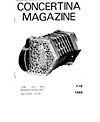 Fingering Systems for Duet Concertina
Fingering Systems for Duet Concertina
-
by Brian Hayden
-
Overview of all the fingering systems for duet concertina which
turned up in Hayden's review of prior art while preparing his own patent application.
As published in Concertina Magazine (Australia)
16 (1986): 19-23; 17 (1987): 7-9; 18 (1987): 11-15; 19 (1987): 6-10.
-
Posted 15 November 2001
-
» read full article in pdf
-
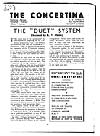 The 'Duet' System, discussed by K. V. Chidley
The 'Duet' System, discussed by K. V. Chidley
-
by Kenneth V. Chidley
-
Review of the history of the duet concertina leading up to
Chidley's own post-war "Chidley System".
As published in World Accordion Review
6:3 (December 1950): 31-32. Also a differing version
as reprinted with notes by Neil Wayne
as K. V. Chidley, "The Duet Concertina--Its History and the Evolution
of its Keyboard," Free Reed: The Concertina Newsletter 17
(Jan/Feb 1974): 15-17.
-
Posted 15 November 2001
-
» read full article in pdf
-
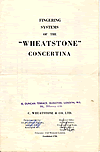 Fingering Systems of the “Wheatstone” Concertina
Fingering Systems of the “Wheatstone” Concertina
-
by C. Wheatstone & Co.
-
A leaflet showing the four concertina systems made by Wheatstone in the
late 1950s: English, Anglo, Chidley duet, and Crane/Triumph duet.
As was Wheatstone’s invariable practise, the Chidley system is
called simply the “Wheatstone Duet” (as the Maccann system had
also been styled previously), and there is no mention of the fact that
the keyboard layout has been changed—apart from the evidence of the keyboard diagram.
The printing is apparently before 1956,
but this copy was issued with overstamping dating from at least 1959.
Collected by Chris Algar.
-
Posted 15 February 2003
-
» read full document in pdf
-
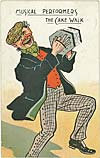 The Life and Times of the Concertina:
the adoption and usage of a novel musical instrument
with particular reference to Scotland
The Life and Times of the Concertina:
the adoption and usage of a novel musical instrument
with particular reference to Scotland
- by Stuart Eydmann
-
This much-anticipated study is the first book-length account of the history and
development of the concertina, in the context of the people who played it and their
music. It is based on field work as well as historical research,
and deals with the concertina in traditional music, art music, sacred music,
band music, the music hall, and many forms of popular
music—reflecting the richness, contradictions, and complexities of
music and society over the more than 150 years since the invention
of the concertina as the high-tech sensation of its day.
Twelve chapters, bibliography of more than 400 items, over 90 figures and musical examples, 365 pages.
Text of thesis for the Ph.D. degree, Open University, 1995.
Supervisors: Dr Peter Cooke and Dr Richard Middleton.
- Posted 15 August 2005
- » read full document
-
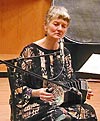 The concertina as an emblem
of the folk music revival
in the British Isles
The concertina as an emblem
of the folk music revival
in the British Isles
- by Stuart Eydmann
-
The post-war folk and traditional music revival in the British Isles was a complex
phenomenon which involved more than just the simple rediscovery and promotion of
neglected music and song. The ideology of key individuals was important in
determining the scope and subsequent diction of the revival including the sources of
the revived repertory and how it should be re-packaged. The selection and use of
appropriate musical instruments was a major issue and, for a time at least, the
concertina family was endorsed by the revivalists to the extent that it could act as a
symbol of the revival itself. This paper identifies and discusses the processes involved.
First published in
British Journal of Ethnomusicology,
vol. 4 (1995), pp. 41–49.
- Posted 15 August 2005
- » read full document
-
 Center for the Study of Free-Reed Instruments
Center for the Study of Free-Reed Instruments
-
by Allan Atlas
-
The CSFRI, part of the Doctoral Program in Music
at the Graduate Center, City University of New York, is
a resource for the scholarly study of all free-reed instruments
(sheng, harmonica, accordion, etc.)
and contains much of interest to concertinists. The site has news
of upcoming concerts, and a listing of books, articles,
recordings, and research material available at the Center's archives.
CSFRI published The Free-Reed Journal (four volumes, 1999–2003),
and now co-publishes the
Papers of the International Concertina Association (PICA)
with the ICA (2004– ).
-
-
Posted 15 February 2003
-
» go to website
-
 The Fayre Four Sisters: Concertina Virtuosi
The Fayre Four Sisters: Concertina Virtuosi
-
by Richard Carlin
- Interviews with Inga, Tina, Sylvia, and Lillian Webb, the “Fayre
Four Sisters,” concertinists on the British music hall and vaudeville circuits.
The sisters were daughters of Joseph Webb (JoJo of the Brothers Webb), and part of
the circle including George Jones, who gave them their first concertina lessons, and
of Frank Butler.
As published in The Free-Reed Journal No. 3 (2001), pp 79–88.
-
Posted 15 January 2005
-
» read full article
-
» read full article in pdf
-
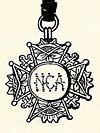 Professor Maccann: “America’s Champion Concertinist”
Professor Maccann: “America’s Champion Concertinist”
-
by Robert Gaskins
-
“PROFESSOR MACCANN, the celebrated concertinist, has
brought back with him from America a fine medal, which
became his property by a rival musician, Amducas Vestman,
failing to meet the Professor in a concertina contest
for the championship and $300. ...”
From The Era newspaper, London, 2 May 1891.
-
Posted 01 June 2003
-
» read full article
-
 Prof. Maccann’s North American Tour (1890–1891)
Prof. Maccann’s North American Tour (1890–1891)
-
by Robert Gaskins
-
Newspaper theatrical notices from the Brooklyn (New York) Daily Eagle describe John Hill Maccann’s
appearances at Hyde and Behman’s Variety Theater, Brooklyn, in November 1890 and February 1891.
Updated 22 December 2003: added a notice from the New York Times for 27 January 1891, during
the same North American tour.
-
Posted 01 June 2003
-
» read full article
-
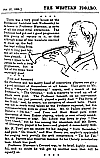 Professor Maccann Performs in Plymouth
Professor Maccann Performs in Plymouth
-
by Robert Gaskins
-
Extended review of a concert presented by Professor Maccann at
the Plymouth Mechanics’ Institute “on an instrument which
he has just patented,” from the Western Figaro newspaper,
Plymouth, 27 February 1885.
-
Posted 01 July 2003
-
» read full article
-
 Wheatstone Anglos with Serial Numbers 50,000+
Wheatstone Anglos with Serial Numbers 50,000+
-
by Robert Gaskins
-
Between 1938 and 1974 Wheatstone & Co.
manufactured concertinas in two parallel series of serial numbers;
Englishes and Duets were given numbers #3XXXX, and Anglos were given
numbers #5XXXX. During these 37 years Wheatstone manufactured about
2,129 Englishes and Duets, with serial numbers from about #34955
through #37083, and some 9,498 Anglos, with serial numbers from #50001
through #59498. Yet, for unknown reasons, this vast population of
late Wheatstone Anglos with #50000+ numbers are not seen nearly as
often as one would expect.
The original version of this article appeared on the net at
concertina.net,
and at
Concertina FAQ.
-
Posted 23 June 2001
-
» read full article
-
 The Wicki System—an 1896 Precursor of the Hayden System
The Wicki System—an 1896 Precursor of the Hayden System
-
by Robert Gaskins
-
The concertina keyboard system known today as the "Hayden" system,
which was independently discovered by Brian Hayden and patented by him in 1986,
had also been discovered and patented 90 years earlier by a Swiss inventor
named Kaspar Wicki. Wicki's 1896 Swiss patent (CH13329) is clear and unambiguous, including
a keyboard diagram labeled in standard musical notation.
-
Posted 01 March 2004
-
» read full article
-
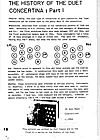 History of the Duet Concertina
History of the Duet Concertina
-
by Phil Inglis
-
When it was written, this was the only survey article on the subject, plus some anecdotes. The
last twenty years have produced some additional information.
As published in Concertina Magazine (Australia), 12 (Autumn, 1985): 18-19,
13 (Winter, 1985): 18-20, 14 (Spring 1985): 11-13.
-
Posted 15 February 2003
-
» read full article in pdf
-
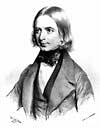 Giulio Regondi in Ireland
Giulio Regondi in Ireland
-
by Thomas Lawrence
-
New information about Giulio Regondi, guitarist and concertinist, who performed on
Wheatstone’s patent concertina in Ireland as early as 1834, the earliest reference to the concertina
in the British Isles.
In PaGes [University
College, Dublin, postgraduate students in the Faculty of Arts] 6 (1999),
on the web at
http://www.ucd.ie/pages/99/articles/lawrence.pdf.
-
Posted 15 August 2003
-
» go to website
-
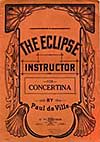 Back to the Future: De Ville’s The Concertina and How to Play It
and Other Tutors
Back to the Future: De Ville’s The Concertina and How to Play It
and Other Tutors
- by Randall C. Merris
-
Paul de Ville's tutor (1905) is one of the most widely available sources
of basic instruction and tunes for the Anglo concertina. It
has links to both earlier and later periods; most of its tunes and
other material were taken from earlier publications, and most of its
contents reappeared seventy years later in a tutor which is still available
for purchase.
- Posted 15 February 2003
- » read full article
-
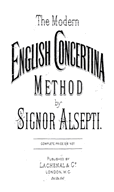 Instruction Manuals for the English, Anglo, and Duet Concertina: An Annotated Bibliography
Instruction Manuals for the English, Anglo, and Duet Concertina: An Annotated Bibliography
- by Randall C. Merris
-
A comprehensive bibliography with more than 200 citations for
concertina tutors that were published from the 1840s to the present.
Separate sections deal with English, Anglo, and Duet tutors.
The annotations contain
considerable historical material on concertina makers, authors and teachers, performers,
and publishers in the UK, US, and elsewhere. The web version incorporates citations for tutors
that have appeared or were located subsequent to the original publication (about 35 more by 2005)
and adds over 100 scanned photographs of tutor covers.
A number of the tutors are available scanned
in full on this website, and these are indicated in the entries.
The original publication was in The Free-Reed Journal 4 (2002): 85-118,
and a PDF version of the printed article is also available online.
- Posted 01 April 2003; last updated 31 August 2005
- » read full article
- » read Part 1, "English Concertina"
- » read part 2, "Anglo Concertina"
- » read part 3, "Duet Concertina"
- » read original article (without updates) in pdf"
-
 Concertina Connection
Concertina Connection
-
by Wim Wakker
-
With the goal of reintroducing the English concertina into classical music,
this site features articles on playing skills (beginner to advanced)
with music scores, sound files, and photographs. The site offers
new Geuns-Wakker concertinas and restored vintage instruments,
extensive restoration services and replacement parts,
and re-published Victorian and contemporary sheet music.
There are a number of MP3 sound files of older Wheatstone and Lachenal concertinas.
-
-
Posted 15 November 2001
-
» go to website
-
 A Wheatstone Twelve-Sided 'Edeophone' Concertina with Pre-Maccann Chromatic Duet Fingering
A Wheatstone Twelve-Sided 'Edeophone' Concertina with Pre-Maccann Chromatic Duet Fingering
-
by Neil Wayne, Margaret Birley, and Robert Gaskins
-
A duet concertina (serial no. 35074) with a unique fingering arrangement, made by Wheatstone
in 1938, turns out to be a realization of a design from Wm. Wheatstone's patent of 1861.
The instrument is twelve-sided, a Registered Design feature of Lachenal & Co., and it
turns out to be one of at least sixteen twelve-sided instruments made by Wheatstone between
1934 and 1941. The instrument is now in the collection of the Horniman Museum, London.
As published in The Free-Reed Journal 3 (2001): 3-17.
This HTML version of the article adds a number of additional photographs and
active links to many of the sources cited in the published article.
Updated 15 August 2003: Footnote 11 updated to record that Randall C. Merris has
located instrument serial #33301, another of the set of three twelve-sided 40-key Anglos.
-
Posted 15 November 2001; last updated 15 August 2003
-
»
read full article
-
»
read original article (without updates or additions) in pdf
Do you know another resource that we should include?
Tell us about it.
Reprinted from the Concertina Library
http://www.concertina.com
© Copyright 2000– by Robert Gaskins
|
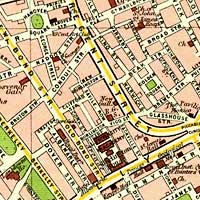
Map showing Conduit Street,
Regent Street, London, c. 1900
Search Concertina Library
|













